Spicy cilantro on the windowsill of your summer cottage
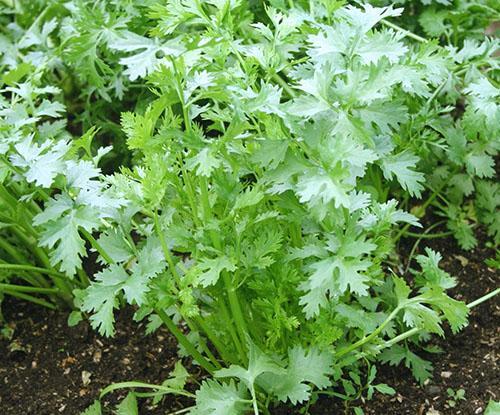 Cilantro (Coriandrum sativum or coriander, Chinese parsley, kuzbara, shlondra, kalyandra) is an annual, unpretentious, fast-growing herbaceous herb from the umbrella family (celery). Its seeds and young greens are eaten as a spicy seasoning, and also used in the pharmaceutical and perfume industries.
Cilantro (Coriandrum sativum or coriander, Chinese parsley, kuzbara, shlondra, kalyandra) is an annual, unpretentious, fast-growing herbaceous herb from the umbrella family (celery). Its seeds and young greens are eaten as a spicy seasoning, and also used in the pharmaceutical and perfume industries.
The homeland of cilantro is located on the shores of the Mediterranean Sea. As early as 5000 years ago, this herb was mentioned in their manuscripts by the ancient Egyptians, somewhat later by the Jews in the Old Testament. Since then, cilantro has spread almost all over the world and in some places even began to grow like a weed. Today cilantro is one of the most widespread spices in the world. Young greens are used in dishes mainly fresh. Cilantro seeds are used as a flavored powder.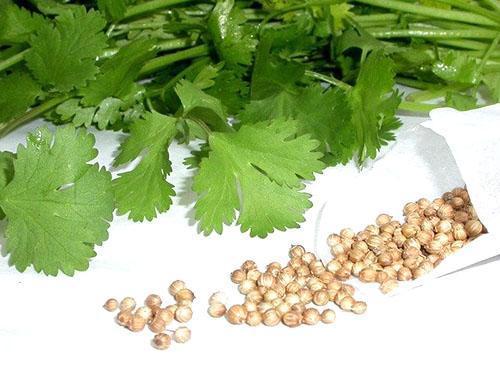
Although the official name for cilantro is Coriandrum sativum, in Russia the dried seeds of this plant are called coriander, and cilantro is its green part.
In addition to gastronomic advantages, cilantro has pronounced healing properties. Eating it in food normalizes the work of the gastrointestinal tract and kidneys, helps cleanse the body of toxins, destroy parasites, strengthen the cardiovascular and nervous systems of the body, heal wounds and skin diseases. Cilantro is contraindicated only for thrombophlebitis, postinfarction and post-stroke syndromes, during pregnancy and lactation.
Knowing the beneficial properties of this wonderful plant, we immediately ask ourselves the question: how to grow cilantro? The plant is not difficult at all to sow and care. It can be grown all year round: in the summer in the garden, and in the winter in a pot. on the windowsill.
Cilantro: planting and care
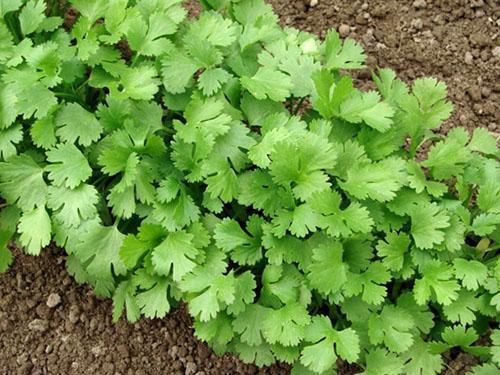 Cilantro belongs to cold-hardy plants. It is able to withstand frosts down to -5˚ C. Therefore, sowing can begin in early spring, when the soil thaws. Sowing in a greenhouse will allow for an even earlier harvest. You can also carry out podzimny sowing, so that with the first spring days you have fresh vitamin greens on the table.
Cilantro belongs to cold-hardy plants. It is able to withstand frosts down to -5˚ C. Therefore, sowing can begin in early spring, when the soil thaws. Sowing in a greenhouse will allow for an even earlier harvest. You can also carry out podzimny sowing, so that with the first spring days you have fresh vitamin greens on the table.
The coriander planting site should be sunny all day long. This plant does not like shade. When shaded, cilantro bushes grow weak, slightly leafy, quickly gain flower stalks. In this case, the fruits become smaller and their ripening is delayed.
Sowing is carried out with dry seeds, laying out 2-3 seeds at a distance of 8-10 cm in the longitudinal grooves on the garden bed. If the seeds are sown more often, the plants will gain little green mass and will quickly go into bloom. The grooves should be spaced 10-15 cm apart to provide the plants with maximum illumination. The seeds of coriander are large enough, so they are sealed to a depth of 1-2 cm. After sowing, the garden bed must be watered abundantly.
Coriander seeds lose germination relatively quickly. Therefore, for sowing, seeds should be taken not older than two years, although they can be stored as a spice much longer.
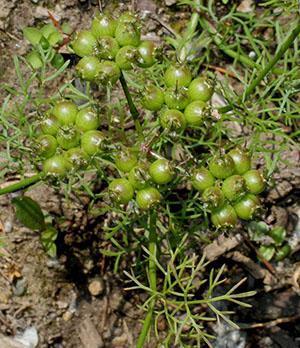 Seedlings appear, depending on the variety, storage period of seeds and weather conditions, within 5 - 20 days. After planting cilantro, caring for it is simple:
Seedlings appear, depending on the variety, storage period of seeds and weather conditions, within 5 - 20 days. After planting cilantro, caring for it is simple:
- Thinning. So that the plants do not compete for a place in the sun and a feeding zone on the earth, out of several plants that have emerged in one nest, only one, the strongest, should be left.
- Weeding. Cilantro does not tolerate thickening.Otherwise, instead of juicy green shoots in the garden, the umbrellas of the peduncles will quickly stretch out.
- Regular watering... After sowing and before the first shoots appear, the bed should be watered abundantly so that the cilantro embryos do not lack nutrition and moisture. When the first green bores appear above the ground, watering should be shortened. While the sprouts are gaining strength, it is enough just to keep the garden moistened. With the beginning of an active set of green mass, it is necessary to start watering the plantings again more and more often so that young plants do not go into bloom ahead of time. But at the stage of fruit ripening, watering should be reduced to a minimum.
- Loosening row spacings... On dense, poor soils, cilantro gives little greenery and quickly gains inflorescences.
The soil for coriander should be slightly alkaline or neutral, loose, nutritious, and conducts moisture well. It can be loam and sandy loam, properly filled with organic matter and mineral complex fertilizers.
Cilantro is not fed during active growth! All nutrients under it should be introduced in advance. In autumn, potash and phosphorus fertilizers, as well as compost, are added to the soil. In the spring, before sowing, nitrogen fertilization is applied.
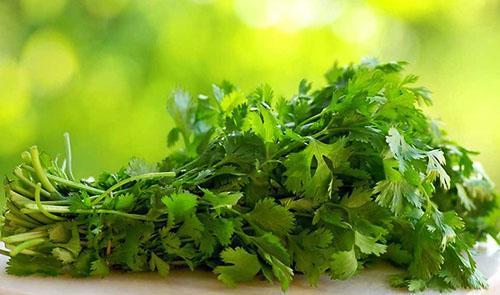 The green mass from the plants is cut off as it grows. Collect greens before discarding flower baskets. After the peduncles start to grow, the green mass of plants coarsens and becomes scarce. Observing the rules of agricultural technology, greens from each plant can be collected up to three times per season.
The green mass from the plants is cut off as it grows. Collect greens before discarding flower baskets. After the peduncles start to grow, the green mass of plants coarsens and becomes scarce. Observing the rules of agricultural technology, greens from each plant can be collected up to three times per season.
Cilantro on the windowsill
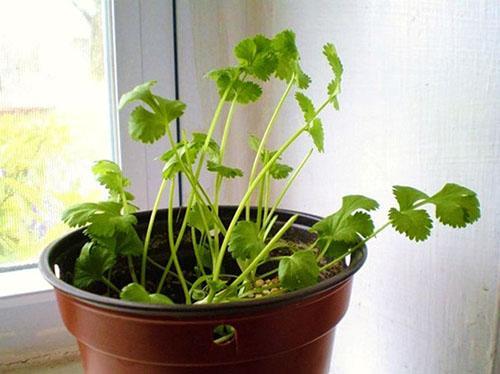 Favorite coriander can delight with its bright taste all year round. Growing cilantro at home is a snap. To do this, you will need:
Favorite coriander can delight with its bright taste all year round. Growing cilantro at home is a snap. To do this, you will need:
- The sunniest place in the apartment is on the balcony, on the windowsill. The more sun you are able to provide to this curly southerner, the more generously he will thank you with juicy greenery. It is best to grow cilantro on a south-facing windowsill.
- Planting containers. They should be chosen depending on the amount of greenery you are going to get. For a small bunch of green cilantro, you can use a regular flower pot with large holes in the bottom. It is desirable that the pot is ceramic, without glaze - such pots have much better air permeability than plastic ones. If you plan to grow more spicy herbs, then it is better to use seedling containers. Better if it is a wooden box - for the same reasons of breathability. In plastic containers, coriander can also be grown quite successfully, but this will require more thorough loosening of the soil. Drainage should be laid at the bottom of the containers to drain excess moisture.
- Soil for planting seeds. The soil should be loose, nutritious and moisture-permeable. Garden soil can be used by sifting earthworms away. You can use a ready-made universal primer purchased from a store. As a top dressing before sowing, a small amount of nitrogen fertilizer can be added to the soil, for example, urea.
- Fresh seeds. The fresher the seeds are, the stronger and more friendly shoots they will give.
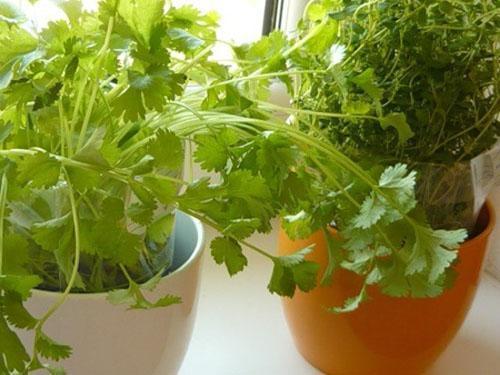 Up to 5 plants (5 nests) can be planted in one pot. Too thicken the crops is not worth it, so as not to cause pulling of the seedlings. If you use a seedling box, then sow cilantro in lines, leaving 4-5 cm between plants and 10 cm between lines. Seeds are sealed in 2-3 pieces in separate holes to a depth of 1-2 cm.
Up to 5 plants (5 nests) can be planted in one pot. Too thicken the crops is not worth it, so as not to cause pulling of the seedlings. If you use a seedling box, then sow cilantro in lines, leaving 4-5 cm between plants and 10 cm between lines. Seeds are sealed in 2-3 pieces in separate holes to a depth of 1-2 cm.
The cilantro plant has a straight taproot with poorly developed adventitious roots. Any, even minor damage to the main root leads to the death of the plant. Therefore, cilantro cannot be transplanted, but must be sown immediately to a permanent place.
After sowing the seeds, it is recommended to cover the pot on top with glass or film, put a plastic bag over the pot.This procedure, when growing cilantro at home, will help maintain a constant level of humidity and temperature, which is much needed for germinating seeds. When the seeds sprout, the greenhouse must be removed.
At the stage of 1-2 true leaves, the plants must be thinned out, removing the weak ones and leaving the strongest and strongest in each nest. You need to water the seedlings regularly, but little by little, so that the earthen lump in the pot is moderately moist. Excess water from the pan must be drained. In winter, if the plants are stretched, additional lighting is needed.
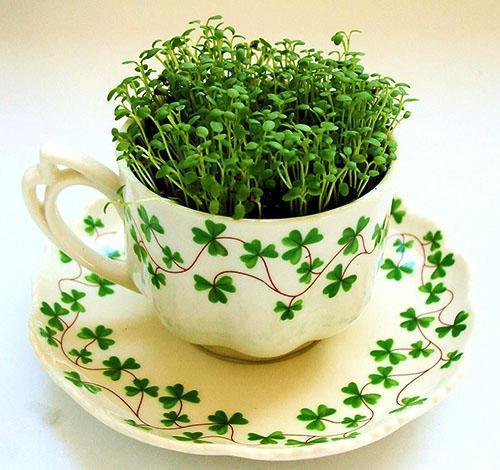 You can sow cilantro densely in a small container to grow it in a bundle for single use. But in order for such a beam to turn out to be large and juicy, additional illumination is definitely required. You can collect the first cilantro greens from the windowsill in a month. Unlike gardening, cilantro grown at home should not be cut at the root. You just need to pick off the leaves from it and use them for food. When peduncles appear, they must be pinched immediately so that the plant continues to grow greenery.
You can sow cilantro densely in a small container to grow it in a bundle for single use. But in order for such a beam to turn out to be large and juicy, additional illumination is definitely required. You can collect the first cilantro greens from the windowsill in a month. Unlike gardening, cilantro grown at home should not be cut at the root. You just need to pick off the leaves from it and use them for food. When peduncles appear, they must be pinched immediately so that the plant continues to grow greenery.
Storing cilantro
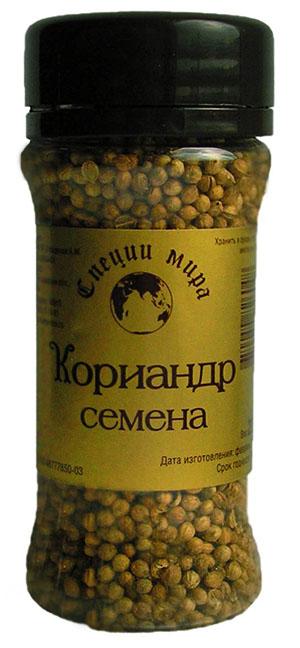 Since we use not only fresh herbs for food, but also dry seeds, a few words should be said about the storage of cilantro. Cilantro greens, when dried, lose almost all of their aroma. Therefore, it makes no sense to procure it for future use in this way. But coriander seeds, on the other hand, retain their bright aroma perfectly for many years if you create the appropriate storage conditions for them.
Since we use not only fresh herbs for food, but also dry seeds, a few words should be said about the storage of cilantro. Cilantro greens, when dried, lose almost all of their aroma. Therefore, it makes no sense to procure it for future use in this way. But coriander seeds, on the other hand, retain their bright aroma perfectly for many years if you create the appropriate storage conditions for them.
For storage, the seeds are thoroughly dried. The complete absence of moisture is the main guarantee of long-term storage of cilantro. The dried seeds are placed in tight containers and sealed hermetically. For this, plastic bags in 2-3 layers, glass or plastic jars with lids are suitable. In this form, coriander seeds can be stored for a very long time without losing their taste and healing qualities. Skillful housewives will always find use for this amazing plant and its aromatic fruits.
Grind coriander seeds into powder immediately before using them, and add to dishes just before the end of cooking. This allows the spice to reveal its aroma most vividly. With prolonged heat treatment, coriander seeds completely lose their aroma. The same thing happens if you store the spice crushed, and not whole seeds.
Using cilantro in your daily diet greatly enriches its taste and helps to avoid many diseases. Therefore, knowing how to plant cilantro, it is worth giving this amazing plant a little time and care by settling it at home.
How to plant greens - video
It is very easy to grow cilantro in your garden. A groove in a sunny place is enough for her and the bushes will prosper. But I don't manage to use fresh leaves for a long time. It seems that the earth is fertile, and I water it often, and after a month it throws out flower arrows and immediately loses its aroma. I am doing something wrong, but I cannot understand. On the window in the container, the plant stretches, there is little greenery. After reviewing the material, I realized that the plant lacks light in the apartment, it is necessary to organize additional lighting. Parsley and dill can be purchased in the middle of winter, they are grown by local greenhouses, and I have not seen cilantro in stores in the off-season. Therefore, I want to grow my own fragrant seasoning for the New Year's table. I will try to grow it using the recommendations from this page.